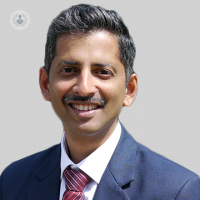Early symptoms of thyroid cancer
Escrito por:The thyroid gland is a gland in the neck in front of the windpipe, just below your Adam’s apple. It’s shaped like a butterfly, with a lobe on the right side and a lobe on the left, with a bridge of tissue connecting the two. The thyroid produces a hormone called thyroxine that we need for metabolism to keep our cells functioning at the correct speed. If too much thyroxine is produced, the cells work faster, causing the body to work too fast (overactive thyroid). If too little thyroxine is produced, the body slows down (underactive thyroid).
General practitioners usually deal with hypothyroidism and hyperthyroidism or sometimes these thyroid problems are referred to endocrinologists. Thyroid surgeons like Mr Jayaram get involved when there’s a swelling in the thyroid called a goitre or a nodule within the thyroid gland.
We asked Mr Sharan Jayaram if a lump in the thyroid is a cause for concern and how to spot the signs of thyroid cancer.

What are the early symptoms of thyroid cancer?
Most patients with thyroid cancer present with a painless lump around the thyroid gland, below the Adam’s apple, generally in the midline or occasionally to the side of the midline. Sometimes the lump may be too small to be visible and instead patients present with swelling of the lymph glands.
Are all lumps in the neck a cause for concern?
The majority of thyroid lumps are benign but must be investigated with an ultrasound scan or sometimes a test called an FNAC (a small biopsy with a needle) to ensure that no early malignancy goes undetected.
The most common cause of neck lumps is swollen lymph glands as a result of a minor infection or inflammation in the head and neck region. It could also be a sign of the common cold. However, any lump that persists for more than three to four weeks or a lump that is growing in size without any obvious signs of inflammation or infection should be investigated.
What are the stages of thyroid cancer and do symptoms change with each stage?
Thyroid cancers are generally divided into stages called T1, T2, T3 and T4. The stages are differentiated based on the size of the tumour within the thyroid or whether cancer has spread to surrounding structures such as muscle, nerves, the windpipe and food pipe. The stage of cancer also depends on whether or not cancer has spread to the lymph glands in the neck or the lungs and bones. The most common form of thyroid cancer is papillary or follicular cancer, which can be effectively treated with an excellent chance of a cure. Treatment generally involves surgery.
Early thyroid cancer, that is T1 and T2 cancers can be treated by surgically removing one half of the thyroid that is cancerous, preserving the other half. Advanced cancers, however, require the removal of the entire thyroid. This is called a total thyroidectomy, which sometimes involves the removal of lymph glands that are affected at the same time. Patients undergoing a thyroidectomy may also require additional treatment in the form of radiation called radioiodine treatment which targets cancer cells and minimises damage to other body cells.
What happens during thyroid cancer surgery?
The operation is done under general anaesthesia. Depending on the stage of cancer, either half of, or the entire thyroid gland is removed. An incision is made in one of the lower neck skin creases to hide the scar. Important structures around the thyroid such as blood vessels and nerves are identified and the blood vessels are tied off. Special attention is given to preserve some important nerves in the neck which are closely related to the thyroid gland, and which are connected to the voice box, making the vocal cords move. These nerves are gently separated from the gland and the gland is removed. Small drainage tubes are inserted into the neck which drains away any excess fluid after the surgery and these tubes are generally removed after 24 to 48 hours. The wound is closed either with dissolvable stitches or sometimes with skin clips and the scars generally heal well.
Aftercare
In the postoperative period, patients may experience some discomfort or pain in the neck which can be controlled with painkillers. If the entire thyroid gland is removed, doctors tend to monitor calcium levels after the surgery because there are tiny glands very close to the thyroid which maintain calcium levels in the body and these may be bruised during the procedure, causing calcium levels to drop. Once calcium levels are normal and once the drainage tubes are out, patients can go home, usually one to three days after the surgery.
To get in touch with Mr Sharan Jayaram, visit his profile on Top Doctors.


